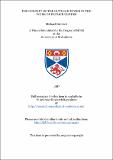The concept of the Outlook Tower in the work of Patrick Geddes
Abstract
As an academic, a scholar and a thinker Patrick Geddes worked in a wide and diverse range of intellectual fields. He was active in biology and botany, geography, sociology, what came to be called town planning, history and the theory and practice of the social sciences. As a man of practical affairs and action he was a patron of art and architecture, rescuer of the Old Town in Edinburgh, founder and funder of the Edinburgh Summer School and a College in Montpellier. As well as Edinburgh he was active in London, Paris, Dublin, America, India, Jerusalem and Montpellier. This protean diversity has called for the two responses from interpreters of his work. The first was to stress the town planning component at the expense of the rest. He has been monopolised by the town planners chiefly through the influence of Lewis Mumford and to a lesser extent Patrick Abercrombie and Frank Mears. The second was to explain his polymathic diversity as the work of an extraordinary personality: such studies have been biographical with a tendency to flattery. This thesis seeks to understand Patrick Geddes as part of the cultural and intellectual life of Scotland. The origins of his town planning work is examined as part of the particular traditions and history of Edinburgh just as his regional planning analyses are seen as part of the tradition of resistance to the cultural domination of London, the imperial metropolis. The role of the Outlook Tower is interpreted as a component of his general theory of pedagogy especially as his concept of the museum relates to this theory. The analyses of his attempt to create a Scottish Renaissance help explain the weakness of his more general sociological and ecological theories.
Type
Thesis, MPhil Master of Philosophy
Collections
Items in the St Andrews Research Repository are protected by copyright, with all rights reserved, unless otherwise indicated.

